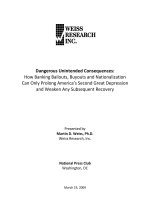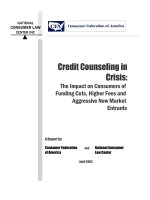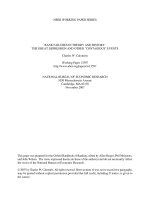rauchway - the great depression and the new deal (2008)
Bạn đang xem bản rút gọn của tài liệu. Xem và tải ngay bản đầy đủ của tài liệu tại đây (1.57 MB, 161 trang )
The Great Depression and the New Deal:
A Very Short Introduction
Very Short Introductions available now:
AFRICAN HISTORY
John Parker and Richard Rathbone
AMERICAN POLITICAL PARTIES
AND ELECTIONS L. Sandy Maisel
THE AMERICAN PRESIDENCY
Charles O. Jones
ANARCHISM Colin Ward
ANCIENT EGYPT Ian Shaw
ANCIENT PHILOSOPHY Julia Annas
ANCIENT WARFARE
Harry Sidebottom
ANGLICANISM Mark Chapman
THE ANGLO-SAXON AGE John Blair
ANIMAL RIGHTS David DeGrazia
ANTISEMITISM Steven Beller
ARCHAEOLOGY Paul Bahn
ARCHITECTURE Andrew Ballantyne
ARISTOTLE Jonathan Barnes
ART HISTORY Dana Arnold
ART THEORY Cynthia Freeland
THE HISTORY OF
ASTRONOMY Michael Hoskin
ATHEISM Julian Baggini
AUGUSTINE Henry Chadwick
BARTHES Jonathan Culler
BESTSELLERS John Sutherland
THE BIBLE John Riches
THE BRAIN Michael O’Shea
BRITISH POLITICS Anthony Wright
BUDDHA Michael Carrithers
BUDDHISM Damien Keown
BUDDHIST ETHICS Damien Keown
CAPITALISM James Fulcher
THE CELTS Barry Cunliffe
CHAOS Leonard Smith
CHOICE THEORY Michael Allingham
CHRISTIAN ART Beth Williamson
CHRISTIANITY Linda Woodhead
CLASSICS
Mary Beard and John Henderson
CLASSICAL MYTHOLOGY
Helen Morales
CLAUSEWITZ Michael Howard
THE COLD WAR Robert McMahon
CONSCIOUSNESS Susan Blackmore
CONTEMPORARY ART
Julian Stallabrass
CONTINENTAL
PHILOSOPHY Simon Critchley
COSMOLOGY Peter Coles
THE CRUSADES Christopher Tyerman
CRYPTOGRAPHY
Fred Piper and Sean Murphy
DADA AND SURREALISM
David Hopkins
DARWIN Jonathan Howard
THE DEAD SEA SCROLLS Timothy Lim
DEMOCRACY Bernard Crick
DESCARTES Tom Sorell
DESIGN John Heskett
DINOSAURS David Norman
DOCUMENTARY FILM
Patricia Aufderheide
DREAMING J. Allan Hobson
DRUGS Leslie Iversen
THE EARTH Martin Redfern
ECONOMICS Partha Dasgupta
EGYPTIAN MYTH Geraldine Pinch
EIGHTEENTH-CENTURY
BRITAIN Paul Langford
THE ELEMENTS Philip Ball
EMOTION Dylan Evans
EMPIRE Stephen Howe
ENGELS Terrell Carver
VERY SHORT INTRODUCTIONS are for anyone wanting a stimulating
and accessible way in to a new subject. They are written by experts, and
have been published in more than 25 languages worldwide.
The series began in 1995, and now represents a wide variety of topics in
histor y, philosophy, religion, science, and the humanities. Over the next few
years it will grow to a librar y of around 200 volumes — a Very Short
Introduction to everything from ancient Egypt and Indian philosophy to
conceptual art and cosmology.
ETHICS Simon Blackburn
THE EUROPEAN UNION
John Pinder and Simon Usherwood
EVOLUTION
Brian and Deborah Charlesworth
EXISTENTIALISM Thomas Flynn
FASCISM Kevin Passmore
FEMINISM Margaret Walters
THE FIRST WORLD WAR
Michael Howard
FOSSILS Keith Thomson
FOUCAULT Gary Gutting
THE FRENCH REVOLUTION
William Doyle
FREE WILL Thomas Pink
FREUD Anthony Storr
FUNDAMENTALISM Malise Ruthven
GALILEO Stillman Drake
GAME THEORY Ken Binmore
GANDHI Bhikhu Parekh
GEOPOLITICS Klaus Dodds
GERMAN LITERATURE Nicholas Boyle
GLOBAL CATASTROPHES Bill McGuire
GLOBALIZATION Manfred Steger
GLOBAL WARMING Mark Maslin
THE GREAT DEPRESSION AND THE
NEW DEAL Eric Rauchway
HABERMAS James Gordon Finlayson
HEGEL Peter Singer
HEIDEGGER Michael Inwood
HIEROGLYPHS Penelope Wilson
HINDUISM Kim Knott
HISTORY John H. Arnold
HIV/AIDS Alan Whiteside
HOBBES Richard Tuck
HUMAN EVOLUTION Bernard Wood
HUMAN RIGHTS Andrew Clapham
HUME A. J. Ayer
IDEOLOGY Michael Freeden
INDIAN PHILOSOPHY Sue Hamilton
INTELLIGENCE Ian J. Deary
INTERNATIONAL
MIGRATION Khalid Koser
INTERNATIONAL RELATIONS
Paul Wilkinson
ISLAM Malise Ruthven
JOURNALISM Ian Hargreaves
JUDAISM Norman Solomon
JUNG Anthony Stevens
KABBALAH Joseph Dan
KAFKA Ritchie Robertson
KANT Roger Scruton
KIERKEGAARD Patrick Gardiner
THE KORAN Michael Cook
LINGUISTICS Peter Matthews
LITERARY THEORY Jonathan Culler
LOCKE
John Dunn
LOGIC Graham Priest
MACHIAVELLI Quentin Skinner
THE MARQUIS DE SADE John Phillips
MARX Peter Singer
MATHEMATICS Timothy Gowers
MEDICAL ETHICS Tony Hope
MEDIEVAL BRITAIN
John Gillingham and Ralph A. Griffiths
MODERN ART David Cottington
MODERN CHINA Rana Mitter
MODERN IRELAND Senia Pas
ˇ
eta
MOLECULES Philip Ball
MUSIC Nicholas Cook
MYTH Robert A. Segal
NATIONALISM Steven Grosby
THE NEW TESTAMENT AS
LITERATURE Kyle Keefer
NEWTON Robert Iliffe
NIETZSCHE Michael Tanner
NINETEENTH-CENTURY
BRITAIN Christopher Harvie
and H. C. G. Matthew
NORTHERNIRELAND Marc Mulhollan d
THE OLD TESTAMENT
Michael D. Coogan
PARTICLE PHYSICS Frank Close
PAUL E. P. Sanders
PHILOSOPHY Edward Craig
PHILOSOPHY OF LAW Raymond Wacks
PHILOSOPHY OF SCIENCE
Samir Okasha
PHOTOGRAPHY Steve Edwards
PLATO Julia Annas
POLITICS Kenneth Minogue
POLITICAL PHILOSOPHY David Miller
POSTCOLONIALISM Robert Young
POSTMODERNISM Christopher Butler
POSTSTRUCTURALISM
Catherine Belsey
PREHISTORY Chris Gosden
PRESOCRATIC PHILOSOPHY
Catherine Osborne
PSYCHOLOGY
Gillian Butler and Freda McManus
PSYCHIATRY Tom Burns
THE QUAKERS Pink Dandelion
QUANTUM THEORY
John Polkinghorne
RACISM Ali Rattansi
THE RENAISSANCE Jerry Brotton
RENAISSANCE ART
Geraldine A. Johnson
ROMAN BRITAIN Peter Salway
THE ROMAN EMPIRE
Christopher Kelly
ROUSSEAU Robert Wokler
RUSSELL A. C. Grayling
RUSSIAN LITERATURE Catriona Kelly
THE RUSSIAN REVOLUTION
S. A. Smith
SCHIZOPHRENIA
Chris Frith and Eve Johnstone
SCHOPENHAUER
Christopher Janaway
SHAKESPEARE Germaine Greer
SIKHISM Eleanor Nesbitt
SOCIAL AND CULTURAL
ANTHROPOLOGY
John Monaghan and Peter Just
SOCIALISM Michael Newman
SOCIOLOGY Steve Bruce
SOCRATES C. C. W. Taylor
THE SPANISH CIVIL WAR
Helen Graham
SPINOZA Roger Scruton
STUART BRITAIN John Morrill
TERRORISM Charles Townshend
THEOLOGY David F. Ford
THE HISTORY OF TIME
Leofranc Holford-Strevens
TRAGEDY Adrian Poole
THE TUDORS John Guy
TWENTIETH-CENTURY
BRITAIN Kenneth O. Morgan
THE VIKINGS Julian Richards
WITTGENSTEIN A. C. Grayling
WORLD MUSIC Philip Bohlman
THE WORLD TRADE
ORGANIZATION Amrita Narlikar
Available soon:
1066
George Garnett
Expressionism
Katerina Reed-Tsocha
Galaxies John Gribbin
Geography
John Matthews and David Herbert
History of Life
Michael Benton
History of Medicine
William Bynum
Law Raymond Wacks
The Meaning of Life
Terry Eagleton
Memory
Jonathan Foster
Mormonism
Richard Lyman Bushman
Nelson Mandela
Elleke Boehmer
Nuclear Weapons
Joseph M. Siracusa
Religion in America
Timothy Beal
Science and Religion
Thomas Dixon
Sexuality
Ve
´
ronique Mottier
The United Nations
Jussi M. Hanhima
¨
ki
The Vietnam War
Mark Atwood Lawrence
For more information visit our web site
www.oup.co.uk/general/vsi/
Eric Rauchway
The Great
Depression &
the New Deal
A Very Short Introduction
1
3
Oxford University Press, Inc., publishes works that further
Oxford University’s objective of excellence
in research, scholarship, and education.
Oxford New York
Auckland Cape Town Dar es Salaam Hong Kong Karachi
Kuala Lumpur Madrid Melbourne Mexico City Nairobi
New Delhi Shanghai Taipei Toronto
With offices in
Argentina Austria Brazil Chile Czech Republic France Greece
Guatemala Hungary Italy Japan Poland Portugal Singapore
South Korea Switzerland Thailand Turkey Ukraine Vietnam
Copyright ß 2008 by Oxford University Press, Inc.
Published by Oxford University Press, Inc.
198 Madison Avenue, New York, NY 10016
www.oup.com
Oxford is a registered trademark of Oxford University Press
All rights reserved. No part of this publication may be reproduced,
stored in a retrieval system, or transmitted, in any form or by any means,
electronic, mechanical, photocopying, recording, or otherwise,
without the prior permission of Oxford University Press.
Library of Congress Cataloging-in-Publication Data
Rauchway, Eric.
The Great Depression and the New Deal : a very short introduction /
Eric Rauchway.
p. cm.— (Very short introductions ; 166)
Includes bibliographical references and index.
ISBN 978–0–19–532634–5 (pbk.)
1. United States—History—1919–1933. 2. United States—History—1933–1945.
3. Depressions—1929—United States. 4. New Deal, 1933–1939.
5. United States—Economic conditions—1918–1945.
6. United States—Social conditions—1933–1945.
7. Roosevelt, Franklin D. (Franklin Delano), 1882–1945.
8. Depressions—1929—Europe.
9. Europe—Economic conditions—1918–1945. I. Title.
E806.R38 2008 973.91—dc22 2007030523
135798642
Printed in the United States of America
on acid-free paper
Contents
Acknowledgments viii
List of Illustrations ix
Introduction 1
1
The World in Debt 8
2
The Hoover Years 23
3
Americans in the Depression 38
4
Reflation and Relief 56
5
Managing Farm and Factory 72
6
Countervailing Power 87
7
The End of the Beginning 105
Conclusion 126
Further Reading 134
Table 1. Major federal acts of the Great Depression
and New Deal
137
Index 143
Acknowledgments
I owe most to scholars cited in the text and am additionally grateful
to Alan Brinkley, Greg Clark, Andrew Cohen, Meg Jacobs, Ari
Kelman, David Kennedy, Peter Lindert, Alan Olmstead, Kathy
Olmsted, Steve Sheffrin, Alan M. Taylor, Louis Warren,
undergraduates enrolled in History 174B at UC Davis in Spring
2007, and the conscientious referees and staff of the press for
valuable comments and conversations about the Great Depression
and New Deal.
List of Illustrations
1 Breadline in New
York City 41
Franklin D. Roosevelt
Library
2 Hooverville squatters’
shacks 45
Library of Congress,
LC-USF34-004976-E
3 GDP and Unemployment 55
Historical Statistics of the
United States, series Ba475
(unemployment) and Ca9
(GDP).
4 Franklin D. Roosevelt during
a ‘‘Fireside Chat’’ 58
Library of Congress,
LC-USZ62-118215
5 Civilian Conservation Corps
poultry farm 79
Franklin D. Roosevelt
Library
6 Civilian Conservation Corps
weeding a Tennessee Valley
Authority nursery 90
Library of Congress,
LC-USW3-004511-D
7 Social Security Act 98
Franklin D. Roosevelt
Library
8 ‘‘White Trade Only’’ 107
Library of Congress, LC-
USF33- 006392-M4
9 Sinclair Lewis’s It Can’t
Happen Here 121
Library of Congress,
LC-USZC2-881
10 WPA Federal Art Project
Mural 122
National Archives and
Records Administration
69-N-P-1304
This page intentionally left blank
Introduction
In 1932 the United States economy stood at its lowest ebb in
modern history. An army of out-of-work military veterans camped
and marched in Washington, DC. Unemployment stood at around
25 percent. Indeed the entire world seemed to have ground to a
halt. Facing this crisis, Franklin D. Roosevelt accepted the
Democratic nomination for president, pledging himself to ‘‘a new
deal for the American people.’’
1
In that speech alone, elements of
the ‘‘new deal’’ included increasing public works, supporting
agricultural prices, creating new mortgage markets, shortening the
working day and week, regulating securities, restoring
international trade, refore sting the countryside, and repealing
Prohibition. After taking office in 1933, Roosevelt worked with
Congress to get laws passed for all these measures and more: by the
end of the decade, the New Deal had grown to include social
insurance against old age, unemployment, and disability;
watershed management; support for unionization; deposit
insurance; and a strengthened Federal Reserve System, among
other innovations.
The New Deal included a variety of sometimes contradictory
components that scholars still struggle to summarize. Often
historians agree with Isaiah Berlin, who said in 1955 that the New
Deal was an impressive balancing act, able ‘‘to reconcile individual
liberty . with the indispensable minimum of organising and
1
authority.’’
2
But as David M. Kennedy notes, we can see the New
Deal thus only when it is ‘‘illumined by the stern-lantern of
history.’’
3
Listening to Roosevelt’s pledges in 1932, watching
Congress pour reforms forth in the first one hundred days of his
administration in 1933, seeing the White House reply to challenges
from the Supreme Court and political opponents in 1935, hearing
Roosevelt campaign as ‘‘the master’’ of corporate interests in 1936,
it would have been hard to discern in advance what seemed clear in
the wake of the decade’s passing. And indeed, there is little proof
that Roosevelt or anyone else set out to create the carefully
balanced system that the New Deal became: it evolved as the
president and Congress responded to the judiciary, the electorate,
and the changing world of the Depression.
In this very short introduction to the Great Depression and the
New Deal, I offer some basic ideas for a first understanding of this
profound crisis and America’s still-influential legislative response.
The world that broke down in 1929 broke down for reasons that
astute observers had predicted in advance. The subsequent and
nearly total failure to repair the damage owed to clear errors of
judgment and action, and the prolonged misery that millions of
people suffered could therefore have been lessened. Roosevelt
and the Democratic Congresses of the New Deal era achieved a
marked historical success by correcting those errors. They also
committed errors of their own, and I do not slight them here.
But in the 1936 election, the American voters overwhelmingly
asked their leaders to forge forward with their experiments,
mistakes aside, rather than return to the old and, to their minds,
wholly discredited ways. This spirit of pragmatic experimentation
became the basis for a generation’s faith in the new American
way, not just in the United States but around the world.
Now, if you doubt the story is quite so simple, and if you insist
that these simple statements require qualifications and nuance,
I shall have to concede the point—beyond the confines of this
brief book, I greatly respect the complexity of this era and the
2
The Great Depression and the New Deal
scholarship covering it. On the principle that you will go on from
here if you wish fully to appreciate the period, the book concludes
with recommendations for further reading. But the body of the
book sticks to these simpler lines of argument on the grounds that
they serve as a useful introduction to the subject.
The Great Depression began in the late 1920s, not necessarily with
the Great Crash of 1929 but around that time, and afflicted a world
tied together by specific kinds of debts, both within and between
countries. Chapter 1 outlines that world and America’s peculiar
place in it, explaining how it differed from the world before World
War I, and emphasizing the vulnerabilities of the system as
outlined by contemporary critics: the web of debt binding that
world together looked fragile to its keenest observers.
Chapter 2 discusses the reactions to the crisis, first of the Federal
Reserve System, which serves the United States as a central bank,
and second of President Herbert Hoover and the Republican
majority in Congress. Contrary to Democratic accusations, the
Republicans did not do nothing—but Hoover’s own principles
prevented him from doing nearly enough, and the crisis worsened
appallingly under his leadership.
Chapter 3 shows that the greatness of the Great Depression owes
to its widespread impact. It afflicted all sections of the American
economy and much of the world. Perhaps most importantly, it
encouraged middle-class American taxpayers and voters to
identify themselves with the unfortunate many, rather the
fortunate few.
The discussion here of the New Deal, like all such discussions,
requires a selective principle to explain what belongs under that
rubric and what does not. You will find two in this book. The first is
chronological. While writers sometimes use the term ‘‘New Deal’’
to refer to the modern Democratic Party’s agenda, or indeed the
expansion of the American state under any administration for any
3
Introduction
purpose after the Roosevelt era (a concept that sometimes goes
under the name, ‘‘the New Deal order’’), I concern myself in this
book chiefly with the 1930s—after which Roosevelt and his
contemporaries thought the New Deal ended—and look only
briefly to its legacy in the war years.
4
The second is functional. I
divide the New Deal here into three parts: (1) those measures that
appear to have worked to reverse the Depression; (2) those that did
not; and (3) those that had little to do with fighting the current
disaster but served to prevent or soften future ones.
Beyond Roosevelt’s core conviction that ‘‘[n]ecessitous men are
not free men,’’ little held the New Deal together.
5
New Deal
programs embodied no single approach to political management of
the economy. They originated in no single book, speech, or person’s
thoughts. In some instances, Roosevelt himself had little to do
with, or even opposed, ultimately important and successful
legislation. The New Deal emerged over time from the fights
between the president, the Congress, the Supreme Court, all of
them influenced by the electoral returns that time after time
supported this continuing conflict, in the interests of creating a
stronger country.
Chapter 4, ‘‘Reflation and Relief,’’ covers the New Deal
stabilization and shoring-up of America’s banks, currency, and
credit, and the simultaneous effort to supply immediate relief to
the Depression’s suffering millions while still keeping American
traditions and institutions intact. These efforts alone, pursued
vigorously, might eventually have ended the Depression, but New
Dealers had greate r ambitions.
Chapter 5, ‘‘Managing Farm and Factory,’’ explains New Deal
attempts to re-create the managed economy of World War I for the
peacetime crisis of the 1930s. These efforts generated controversy
at the time and in retrospect appear considerably ill-advised. But
they had roots deep in American politics, and their failures helped
turn the New Deal into the balanced mechanism it became.
4
The Great Depression and the New Deal
Chapter 6, ‘‘Countervailing Power,’’ considers the ways New
Dealers tried to redistribute influence in the American economy.
They did not use state redistribution of wealth through tax policy
and welfare payments; rather, they used law to encourage interest
groups and individual actors to act independently of their
employers.
By 1936, the use of countervailing power had become a distinctive
hallmark of the New Deal. Never so efficient as direct state action,
the strategy of countervailing power allowed Roosevelt to, in
Berlin’s words, ‘‘establish new rules of social justice . . . without
forcing his country into some doctrinaire strait-jacket, whether of
socialism or State capitalism, or the kind of new social organisation
which the Fascist regimes flaunted as the New Order.’’
6
By such
methods the New Deal gave weaker groups in society the ability to
negotiate better deals in a marketplace it left substantially intact.
The book’s final chapter shows that the American electorate
ratified Roosevelt in the landslide victory of 1936 and explains why
the New Deal nevertheless ground to a halt within a few years after
that. The Supreme Court played its part, and so did Franklin
Roosevelt’s overreaching ambition. But so too did the results of
their first experiments change some New Dealers’ minds. And
finally, the impending war in Europe and America’s response to it
set aside the New Deal’s fiscal caution and experimental care.
The New Deal did not end the Great Depression. As one American
who lived through the 1930s told Studs Terkel, ‘‘industries needed
to make guns for World War II made that happen.’’
7
Unemployment did not return to its 1929 level until 1943.
8
But
while we can therefore say that the New Deal did not finish the job,
we cannot say that it was not working. Throughout the 1930s, with
the exception of the recession in 1937–38, the economy was
improving—growing on average 8 percent a year from 1933–37
and 10 percent a year from 1938–41, while unemployment fell
steadily as well.
9
This impressive rate of recovery reminds us how
5
Introduction
far the United States had to go to recover from the Hoover era. It
also helps explain why the New Deal achieved such political
success.
As a program to reform the American and global political
economy, the New Deal met with more ambiguous fortune because
it blurred into the war. The New Deal started and mainly stayed a
purely American set of solutions to a problem of global
importance, although the Anglo-American trade agreement of
1938 pointed toward an international method of reviving the world
economy. And while the postwar order that Roosevelt in his last
years helped secure for the world owed much to New Deal methods
of pragmatic experimentation and shifting power away from states,
because the war began before the lessons of the New Deal had
made themselves quite clear, observers could not readily
disentangle the two great events. The moral clarity of the 1940s
obscured the hard choices, partial successes, and political bargains
of the 1930s.
In the conclusion I discuss the New Deal’s influence on the postwar
world through the Bretton Woods system of international
agreements for economic stability, which endured until the 1970s.
Not until then did the United States begin to retreat from its New
Deal at home and abroad. And even after several subsequent
decades during which politicians have led a revival in America’s
pre-1929 beliefs, claiming repeatedly that government is a
problem, not a solution, for modern economies, the New Deal’s
basic commitment to shared responsibility for economic security
and its skepticism toward the complete reliability of bankers,
brokers, and corporate executives has not quite died.
Throughout this book, the reader will find these interpretations
guided not only by the easier wisdom of scholarly hindsight, but
also by the perceptive assessments of contemporary observers. Just
as Americans enjoyed the great good fortune of Franklin
Roosevelt’s unique presidential competence in both peace and war,
6
The Great Depression and the New Deal
they had also among them a remarkable generation of social
scientists and other political analysts. The book relies on them as
much as on those who have followed them and profited from their
vision. And on the advice of one of the most acute among them, we
begin with a description of the world that came limping to a halt in
the Great War of 1914–18.
Notes
1. ‘‘Text of Governor Roosevelt’s Speech at the Convention Accepting
the Nomination,’’ New York Times, January 3, 1932, 8.
2. Isaiah Berlin, ‘‘President Franklin Delano Roosevelt,’’ in The Proper
Study of Mankind: An Anthology of Essays, ed. Henry Hardy and
Roger Hausheer (London: Chatto and Windus, 1997), 636–37.
3. David M. Kennedy, Freedom from Fear: The American People in
Depression and War, 1929–1945 (New York: Oxford University
Press, 1999), 365.
4. Steve Fraser and Gary Gerstle, eds., The Rise and Fall of the New
Deal Order, 1930–1980 (Princeton: Princeton University Press,
1989). On the New Deal’s contribution to the later growth of the
executive branch, see Theodore Lowi, The End of Liberalism: The
Second Republic of the United States (New York: W. W. Norton,
1979).
5. Cited in Kennedy, Freedom from Fear, 280. See also Berlin,
‘‘President Franklin Delano Roosevelt.’’
6. Berlin, ‘‘President Franklin Delano Roosevelt,’’ 629–30.
7. Studs Terkel, Hard Times: An Oral History of the Great Depression
(New York: The New Press, 2000), 57.
8. Susan B. Carter et al., eds., Historical Statistics of the United States,
Earliest Times to the Present, Millennial Edition (New York:
Cambridge University Press, 2006), series Ba475. Unemployment
as a percentage of the civilian labor force was 2.9 percent in 1929;
3.1 percent in 1942 and 1.8 percent in 1943.
9. Christina D. Romer, ‘‘What Ended the Great Depression?,’’ Journal
of Economic History 52, no. 4 (1992): 757.
7
Introduction
Chapter 1
The World in Debt
However various the explanations for the Great Depression have
grown, they share an understanding that the world wracked by the
crisis of the late 1920s differed significantly from the world in
which most people had grown up. Inasmuch as the world had a
single, integrated economy, it had recently undergone profound
changes as a result of World War I. The war made it harder for
people, goods, and money to move around the globe, and it shifted
the direction in which they flowed, too. Putting the United States
at the center of this new system, the war also changed America,
rendering the once-peripheral New World nation’s peculiarities
central to the planet’s concerns. Nor do these events and their
potential for disaster appear only in retrospective clarity—some
observers saw them coming.
Looking forward from the Treaty of Versailles at 1919, the
economist John Maynard Keynes forecast what lay in wait for the
industrial world: ‘‘depression of the standard of life of the
European populations to a point which will mean actual starvation
for some (a point already reached in Russia and approximately
reached in Austria). Men . in their distress may overturn the
remnants of organisation, and submerge civilisation itself in their
attempts to satisfy desperately the overwhelming needs of the
individual.’’
1
Depression, desperation, and the dismantling of
civilization would result, Keynes wrote, from ‘‘the economic
8
consequences of the peace,’’ and although Keynes, perhaps
mistakenly, attributed this impending disaster partly to the treaty’s
provisions, he also criticized its omissions.
2
World leaders at
Versailles might have restored and codified the global system
that prevailed from about 1870 to 1914, a system Keynes described
as an ‘‘economic Utopia.’’ But they missed this chance, producing
instead a world quite unlike Utopia.
3
Before 1914, people, goods, and capital crossed national borders
with relative impunity. In consequence, they had the greatest
possible scope to seek a place where their work would yield the
greatest possible profit. To a considerable extent, this movement
across borders meant the export of excess from industrial Europe.
Between the middle of the nineteenth century and World War I,
about fifty-five million people left Europe to find their fortune
in New World nations. Mostly industrial workers looking for
higher wages in a worldwide market for their labor, their departure
from Europe decreased the supply of workers there, raising wages
for the laborers they left behind. Their arrival in the land-rich
nations of the New World helped push development out into
the frontiers. This migration did not occur altogether without
hindrance. To describe the international markets of the nineteenth
century as truly global represents some exaggeration, in large
measure because New World nations preferred some parts of
the globe over others when forging a cross-border market in, for
example, labor. Notably, in the 1850s Australian states
began limiting Chinese immigration, and by the early twentieth
century the United States, Canada, and Australia all had
erected high hurdles to immigration from both China and Japan;
the United States in 1917 not only added a ‘‘barred zone’’ that
blocked almost all the rest of Asia but also adopted a literacy test
to reduce the number of incoming people. Nevertheless,
these restrictions let millions of immigrants, particularly from
southern and eastern Europe, move to better employment in the
New World.
9
The World in Debt
During the same period, the British empire generally backed the
free movement of goods across borders. The relatively untaxed
passage of things in trade—raw materials and finished products
alike—between the Old World and the New allowed each nation to
produce mainly what it was best suited to make. Although
countries of the era sometimes raised barriers to trade as they did
to migration—Latin American countries had especially high
tariffs—international trade moved with relative freedom,
especially compared to the 1920s, and Britain led in the promotion
of lower tariffs.
4
Observers noted that trade with Britain proved especially useful to
many developing countries. British banks backed the builders of
roads, canals, and railways as these countries stretched into their
hinterlands and prairies. Bringing the fields under tillage made the
New World more productive, and selling products back to their
lender, Britain, helped developing countries defray their debts.
Combined with the movement of goods and people, the movement
of capital created a virtuous circle, at least so far as Europe was
concerned. As a British economist wrote in 1909, ‘‘by the
investment of capital in other lands we have, first, provided the
borrowing countries with the credit which gave them the power to
purchase the goods needed for their development, and secondly,
enabled them to increase their own productions so largely that they
have been able to pay us the interest and profits upon our capital
and also to purchase greatly increased quantities of British goods.’’
5
Keynes regarded this vanished system so highly because it had
allowed Europe for the first time to relieve the pressure that an
increase of population had appeared inexorably to put on the
supply of food. Keynes explained: ‘‘With the growth of the
European population there were more emigrants on the one hand
to till the soil of the new countries, and, on the other, more
workmen were available in Europe to prepare the industrial
products and capital goods which were to maintain the emigrant
populations in their new homes, and to build the railways and
10
The Great Depression and the New Deal
ships which were to make accessible to Europe food and raw
products from distant sources.’’
6
The war shut down this system.
People and goods could no longer move freely, and their formerly
productive power went instead toward destruction. Capital funded
the war’s western front instead of the New World frontier. But
worse, once the war ended, the peace did nothing to restore the lost
world. ‘‘The Treaty includes no provisions for the economic
rehabilitation of Europe . . . or to adjust the systems of the Old
World and the New,’’ Keynes complained.
7
Looking back from the 1930s, the British historian E. H. Carr
wrote, ‘‘In 1918 world leadership was offered, by almost unanimous
consent, to the United States . . . it was then declined.’’
8
Most
notably, the United States declined to lead the world in
reconstructing the old, open economy. Indeed, it moved in the
opposite direction.
The United States had tried to limit immigration before the war,
but it turned to the task with greater energy and effectiveness in
the 1920s. Congress established quota limits on immigration with
the laws of 1921 and 1924. Other New World countries blocked
immigration in their own ways. Some joined the United States in
barring political radicals and classes of the criminal, poor, or
disabled. Brazilians tried to steer immigration to farms, rather
than cities. Canada’s 1919 immigration act allowed officials to bar
‘‘immigrants . deemed unsuitable owing to their peculiar
customs, habits, [and] modes of life.’’
9
These restrictions made it
harder for Europeans to find opportunities overseas, as Keynes had
foreseen in 1919.
The movement in goods slowed owing to restrictive law as
well. The United States raised tariffs in 1921 and 1922, and
other countries began following suit. Alarmed diplomats
convened conferences whose delegates advocated lifting these
barriers, culminating with the League of Nations’ World Economic
Conference in 1927, which declared itself strongly against tariffs, to
11
The World in Debt
no effect. The Americans had a history of high tariffs stretching
through the nineteenth century, but as the New York Times noted
in 1926, circumstances had changed since then: ‘‘It needs no
political economist to see that our situation in the world of trade
has been radically altered by the events following 1914. A fiscal
policy which might have been defensible before that year has since
gone hopelessly awry. Our immense and increasing investments
abroad cannot indefinitely be paid for unless we are willing to take
what our foreign debtors can offer us.’’
10
With the war the United States had switched positions, almost
overnight, from the world’s great debtor to the world’s great
creditor. New York replaced London as the central lender in the
world’s credit network. This move meant more than merely a shift
in position and priority. Postwar debts differed from prewar
borrowing. New World borrowers spent nineteenth-century
British loans on railroads and ranches, building the capacity to
repay their lenders. Belligerent borrowers spent wartime American
loans on shot and shell, destroying that capacity. Nations wounded
in war borrowed more money to repay their debts, sometimes
borrowing from America to pay other belligerents who in turn paid
America.
This new global system of the 1920s, less open and flexible than its
predecessor, relied on continued American lending to fund deficits
and debts around the war-impoverished world. And for a time,
American lending served this purpose. Then, in 1928, it all but
stopped, sending Germany, Poland, Brazil, Argentina, Australia,
and Canada into recession.
11
But Americans were not looking at
the limping world. They had their eyes on the racing economy at
home.
After the United States recovered from a postwar recession in 1921,
its economy grew at a healthy annual rate. American workers
produced more goods more efficiently, and their incomes
increased, if not quite so quickly as the profits born from their
12
The Great Depression and the New Deal
greater productivity.
12
Many Americans’ optimism grew, too: they
thought they had entered a new era of prosperity, when more
Americans could afford more luxury goods and live, at least
materially, better lives than ever before. So securely did they hold
this belief that they accepted newly available offers of credit in
order to buy what they could not afford from their own pockets. By
the end of the decade Americans were living lives well-furnished
with debt.
Before World War I, the average American household went a little
more into debt each year—maybe a $4 increase over the year
before, excluding mortgages. In the 1920s, the average increase
more than tripled to about $14 a year.
13
With that borrowed money
Americans bought the same goods they were increasingly making:
expensive, durable, luxury items that gave them more varied
amusements and higher expectations from life. The 1920s brought
regular radio programs, and Americans bought radio sets and
phonographs. They bought household appliances, like electric
refrigerators. Most visibly, they bought cars.
14
The production, purchase, and financing of automobiles drove the
perception and reality of American prosperity in the 1920s. The
output of America’s automobile factories more than doubled over
the decade, so that by 1929 the 4.4 million cars they produced were
the single most valuable chunk of U.S. manufacturing output. At
decade’s end about 447,000 people worked in the automotive
industry—only slightly fewer than worked in iron and steel, the
nation’s biggest manufacturing industry. The more cars Americans
made, the more they drove up demand for glass, rubber, steel, and
petroleum. Car-buyers drove the growth of roads, suburban
houses, shopping centers, and other roadside attractions.
15
In 1920 American motor vehicle bureaus recorded only one car
registered for every three households; by the end of the decade the
country had a car for almost every household. In 1929 there were
about 23 million cars for a nation of about 123 million people: at a
13
The World in Debt
cozy fit of six per car, the whole country could have gone on the
road at once.
16
Henry Ford’s motor company provided some of the technical and
business innovations that made these changes possible. By World
War I, Ford had settled on the Model T as its all-purpose consumer
model, developed the moving assembly line as a method of mass
production, and began touting the high wages its workers earned,
as a way of ensuring their loyalty and their ability to purchase the
company’s signature product, whose price fell and fell over the
years, from around $950 in 1909 to a low of $290 in 1926.
17
Were Ford’s the whole story of the automobile industry and, by
extension, American manufacturing in the 1920s, it would sound
something like this: higher wages, lower prices, and the mass
production of a standard item made what was once a luxury into a
commonly available commodity. But this is not the whole story.
Despite the Model T’s falling sticker price, major durable goods
generally cost more in relation to other products in the 1920s than
they had before the war. Americans did not buy these products in
such quantities because they were cheap: they bought despite the
expense.
18
Ford’s inexpensive, standard Model T made it possible for more,
different people to own cars. But at some point, everyone who
could afford a car would have one, and then who would buy?
General Motors (GM) decided to make sure that the same people
would keep buying different cars: it introduced planned
obsolescence by annually changing its models, and to allow for the
extravagance of regular new cars, GM began extending credit
through the General Motors Acceptance Corporation.
19
Often the ready credit of the 1920s came dear, at an annual interest
rate of around 30 percent on an installment plan for a new car.
20
Even though moralists—Henry Ford among them—fretted over
the ever-expanding definition of what Americans needed to buy,
14
The Great Depression and the New Deal









